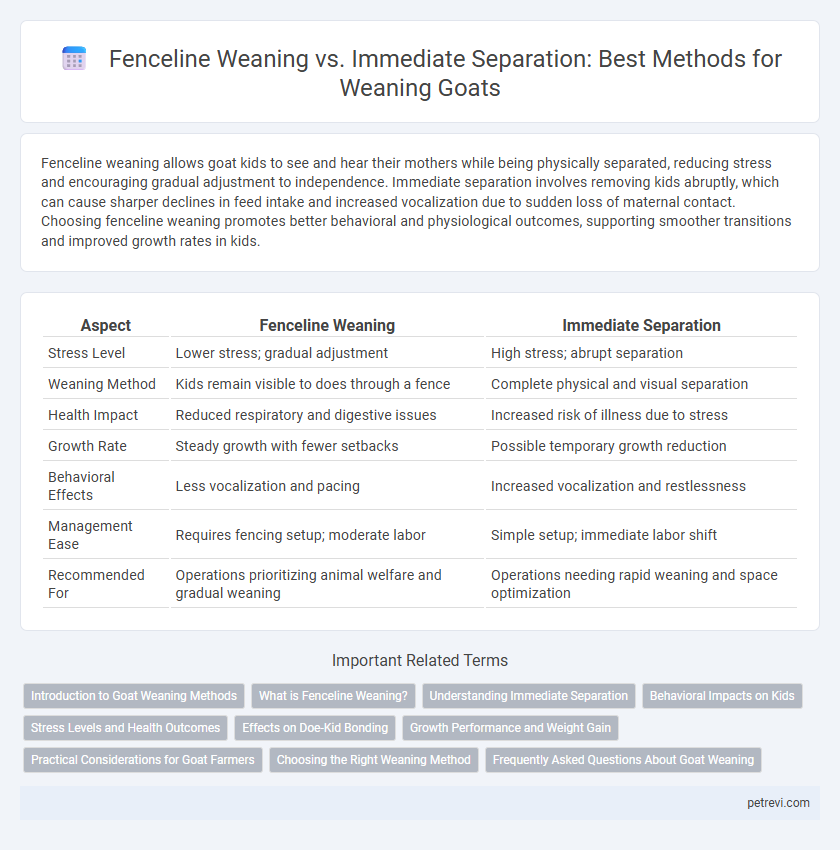Fenceline weaning allows goat kids to see and hear their mothers while being physically separated, reducing stress and encouraging gradual adjustment to independence. Immediate separation involves removing kids abruptly, which can cause sharper declines in feed intake and increased vocalization due to sudden loss of maternal contact. Choosing fenceline weaning promotes better behavioral and physiological outcomes, supporting smoother transitions and improved growth rates in kids.
Table of Comparison
| Aspect | Fenceline Weaning | Immediate Separation |
|---|---|---|
| Stress Level | Lower stress; gradual adjustment | High stress; abrupt separation |
| Weaning Method | Kids remain visible to does through a fence | Complete physical and visual separation |
| Health Impact | Reduced respiratory and digestive issues | Increased risk of illness due to stress |
| Growth Rate | Steady growth with fewer setbacks | Possible temporary growth reduction |
| Behavioral Effects | Less vocalization and pacing | Increased vocalization and restlessness |
| Management Ease | Requires fencing setup; moderate labor | Simple setup; immediate labor shift |
| Recommended For | Operations prioritizing animal welfare and gradual weaning | Operations needing rapid weaning and space optimization |
Introduction to Goat Weaning Methods
Goat weaning methods significantly impact kid health and growth, with fenceline weaning and immediate separation being common strategies. Fenceline weaning allows gradual adaptation by maintaining visual and limited physical contact between does and kids, reducing stress and promoting smoother transitions. Immediate separation involves complete and sudden separation, which can increase stress but may simplify management and prevent disease transmission.
What is Fenceline Weaning?
Fenceline weaning is a method where goat kids are separated from their mothers by a fence, allowing visual, auditory, and limited physical contact while preventing nursing. This gradual separation reduces stress and behavioral issues commonly seen with immediate separation by helping kids and does adjust to the change more smoothly. Research shows that fenceline weaning improves weight gain and lowers cortisol levels compared to abrupt weaning methods in goat kids.
Understanding Immediate Separation
Immediate separation in goat weaning involves removing kids from their mothers abruptly, which can lead to increased stress and vocalization in both does and kids. This method may result in quicker adaptation to solid feed but poses greater risk of growth suppression and decreased immune function due to the sudden loss of maternal contact. Understanding the physiological and behavioral impacts of immediate separation is crucial for managing animal welfare and optimizing post-weaning performance in goats.
Behavioral Impacts on Kids
Fenceline weaning reduces stress-related behaviors in goat kids by allowing gradual acclimation to the absence of their dams, promoting smoother social transitions and lower vocalization rates. Immediate separation often triggers heightened anxiety, increased bleating, and aggressive behaviors due to abrupt loss of maternal contact. Studies show fenceline weaning supports better weight gain and overall welfare outcomes by minimizing behavioral distress during weaning.
Stress Levels and Health Outcomes
Fenceline weaning in goats reduces stress levels by allowing gradual separation, which lowers cortisol and behavioral signs of distress compared to immediate separation. This method supports better health outcomes with improved weight gain, enhanced immune function, and decreased incidence of respiratory and gastrointestinal diseases. Immediate separation often leads to elevated stress hormones, weakened immunity, and higher susceptibility to illness during the critical weaning period.
Effects on Doe-Kid Bonding
Fenceline weaning in goats allows continuous visual and limited physical contact between doe and kid, promoting gradual reduction of dependence and minimizing stress-related behaviors. Immediate separation abruptly disrupts the doe-kid bond, often resulting in heightened vocalizations, increased cortisol levels, and decreased feed intake in both. Studies suggest that fenceline weaning supports better long-term social integration and maternal behaviors compared to immediate separation methods.
Growth Performance and Weight Gain
Fenceline weaning in goats promotes superior growth performance and weight gain compared to immediate separation by reducing stress and maintaining social interaction. Studies indicate that kids weaned using the fenceline method exhibit higher average daily gains and improved feed intake efficiency. The gradual transition supports better adaptation and sustains optimal growth rates during the critical weaning period.
Practical Considerations for Goat Farmers
Fenceline weaning for goats offers practical benefits by reducing stress through visual and limited contact with kids, which can lead to better weight gain and calmer behavior compared to immediate separation. Immediate separation requires less infrastructure but often causes increased vocalization and potential health issues due to elevated stress levels. Goat farmers should balance available resources, herd size, and labor capacity when choosing between methods to optimize animal welfare and productivity.
Choosing the Right Weaning Method
Choosing the right weaning method for goats significantly influences their stress levels, growth rates, and overall health. Fenceline weaning allows kids to maintain visual and limited physical contact with their mothers, reducing cortisol levels and promoting a smoother transition compared to immediate separation, which often causes acute stress and weight loss. Implementing fenceline weaning optimizes welfare and supports better post-weaning weight gain, making it a preferred strategy for improving goat production outcomes.
Frequently Asked Questions About Goat Weaning
Fenceline weaning allows goat kids to remain in sight, sound, and smell of their mothers, reducing stress and encouraging gradual adaptation to independence. Immediate separation may cause higher stress levels and vocalization but can be necessary in certain management situations or disease control. Choosing between fenceline weaning and immediate separation depends on herd health, management goals, and the individual behavior of does and kids.
Fenceline Weaning vs Immediate Separation for Goat Weaning Infographic

 petrevi.com
petrevi.com